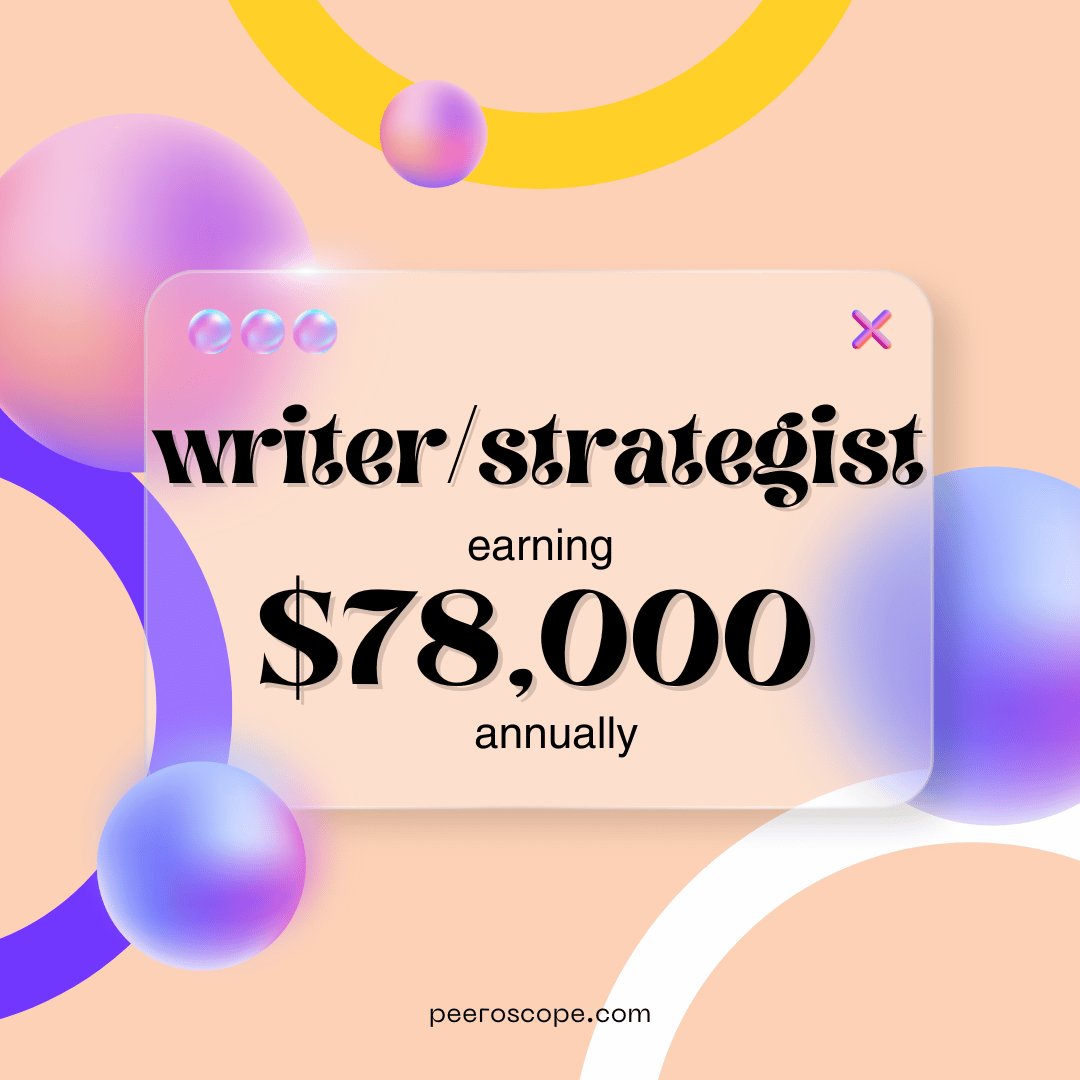Welcome to Freelance Files. A place where freelancers anonymously share a detailed peek at their business. Today, we get to hear from a freelancer from the United States who has been freelancing for over seven years and charges an average of $2,500 to $6,500 per month, per project for global brands like PepsiCo, Yahoo, Stanley, TikTok, and Neutrogena.
If you’d like to submit your own Freelance File, please do so through our online form.
What is your primary freelancing field? Writer, Copywriter, Social Media Manager, Content Writer, Content Strategist
How long have you been freelancing in this field? 7+ years
Where do you live? Austin, TX
Do you freelance full-time or part-time? Full-time
Do you feel the freelance world has become easier or harder than it was 1 year ago? 5 years ago? Please explain. The freelance world has definitely become harder than it was a year ago, and even more so compared to five years ago. This year in particular, I’ve seen a noticeable slowdown in new opportunities, largely due to economic factors beyond my control. Many companies are tightening budgets, pausing freelance engagements, or shifting resources in-house, which has made it more competitive and unpredictable. Even long-term relationships and repeat clients have been impacted by broader team restructures or spending freezes. While freelance work has always required adaptability, the current landscape demands even more persistence and strategic networking just to maintain momentum.
What types of clients do you typically work with? I typically work with a mix of agencies and major corporations. Primarily in CPG, lifestyle, beauty, and tech. I’ve partnered with global brands like PepsiCo, Yahoo, Stanley, TikTok, and Neutrogena, often through agencies like Movers+Shakers or directly as a freelance creative. I’m comfortable navigating both in-house and agency workflows, whether it’s launching a campaign for a Fortune 500 brand or adapting creative for fast-paced social teams.
How do you find most of your clients? Social Media – mainly LinkedIn.
Do you feel you are paid fairly for your work? Why or why not? In most cases, yes—I’m typically paid fairly, especially for freelance projects where the scope is clearly defined and aligned with my experience. That said, there have been situations where I’ve taken on responsibilities well beyond my initial role—like stepping into strategy, production, or client comms—and the pay hasn’t always reflected that added value. I’m happy to be flexible and collaborative, but I do believe compensation should scale with contribution.
How many hours do you typically work per week? 30 to 40 depending on team needs.
What is your average project rate? My average project rate typically ranges from $2,500 to $6,500 per month, depending on the scope—whether it’s a full paid social campaign, trend report, content strategy, or creative development. For smaller deliverables like copywriting or one-off decks, I also offer flat rates or hourly options, usually between $55-$65/hr. I’m always open to aligning on scope and structure based on team needs.
If you can remember, what were your rates when you first started out. How have they changed since then? When I first started freelancing, my rates were around $30–$40/hour, and I often undercharged—especially when wearing multiple hats across copy, strategy, and content – plus I want to gain the experience with a specific brand. Over time, as I gained experience with high-profile brands like TikTok, PepsiCo, and Stanley, and started leading larger-scale campaigns, I gradually raised my rates to reflect the value, strategy, and performance impact I bring. Now, my typical hourly is $55–$70, and project rates range higher depending on complexity and deliverables.
What percentage of your time is spent on unpaid tasks? Roughly 20–30% of my time goes to unpaid tasks like client outreach, admin, revisions beyond scope, and prepping decks or briefs. I try to streamline where I can, but as a freelancer, there’s always a chunk of time spent managing the business side especially when juggling multiple clients or stepping into hybrid roles.
How many clients do you work with at any given time? 1-2
How much did you earn last year? $78,000
How do your clients pay you?
- Bank transfer
- PayPal
- Freelance platform (e.g., Upwork, Fiverr)
Do you expect to earn the same, less, or more this upcoming year? More
Do you account for taxes, vacation, or sick time in your pricing? If yes, how? If no, why? Yes, I do factor those into my pricing. Since I’m self-employed, I build a cushion into my rates to cover self-employment taxes, unpaid time off, and unexpected downtime. I generally estimate about 30% overhead when setting project or hourly rates, which helps ensure sustainability even when I’m between projects, sick, or taking a break. It’s not a perfect science, but it keeps me covered.
What’s your biggest source of instability as a freelancer? Inconsistent client work
What are your typical monthly expenses related to freelancing? On average, my freelance-related monthly expenses range from $800 to $1,200, depending on workload. That includes:
- Software subscriptions (Adobe Creative Cloud, Canva Pro, Google Workspace, etc.): ~$150
- Taxes & savings allocation: ~25–30% of income
- Coworking or home office costs (Wi-Fi, utilities, occasional space rental): ~$100–200
- Portfolio, web hosting, LinkedIn Premium, etc.: ~$50
- Professional development or industry tools (courses, AI tools, trend platforms): varies, but ~ $50–100
I keep a buffer for unexpected expenses like equipment, legal/accounting support, or travel.
What tools can’t you live without as a freelancer? I rely on a mix of creative, communication, and organizational tools to keep things running smoothly. My must-haves:
- Google Workspace – for everything: briefs, decks, contracts, and collaboration
- Slack – essential for real-time client comms and agency workflows
- Canva Pro & Adobe Creative Cloud – for moodboarding, content templates, and quick visual mockups
- Notion – for tracking projects, rates, invoices, and goals
- Loom – to walk clients through decks or feedback when async is easier
- QuickBooks Self-Employed / Wave – for invoices, tax prep, and expense tracking
- TikTok & Meta Ads Manager – for campaign monitoring, A/B testing, and performance tweaks
- ChatGPT – honestly a huge help for outlining ideas, refining scripts, or speeding up strategy work
How do you determine your rates? It’s a mix of market research, experience level, and project scope. I regularly benchmark against industry standards and talk with other freelancers to stay aligned with current rates. I also factor in the value I bring—especially if I’m stepping into multiple roles like strategy, copywriting, and creative direction. Experience matters too: after working with major brands like Yahoo, Stanley, and PepsiCo, I know what kind of impact I deliver, and I price accordingly. That said, there’s still some gut instinct involved—especially when a project feels like a stretch creatively or logistically.
What is your biggest challenge as a freelancer? My biggest challenge is scope creep—when projects expand beyond the original ask without a conversation about additional compensation. I’m naturally collaborative and often step up when teams need extra support, but that can blur boundaries if expectations aren’t clearly reset. Over time, I’ve learned to better define scope up front and advocate for my time, but it’s still a balancing act between being flexible and protecting sustainability.
How often do you raise your rates with clients and how does that conversation usually go? To be honest, I don’t raise my rates as often as I probably should. I tend to prioritize long-term relationships and consistent work, so I’ve sometimes kept rates steady even as the scope or value has increased. When I do raise them, it’s usually tied to a new project or a natural contract refresh point, and I frame it around expanded responsibilities, market shifts, or the results I’ve delivered. But it’s still something I’m working on being more proactive and confident about.
What’s one thing you wish you had known before starting freelancing? I wish I had known just how harder freelancing is than it looks. It’s not just doing the work—it’s running a business, adapting to wildly different team cultures, and staying organized while switching between brands, platforms, and expectations. Every team functions differently, so you have to be highly adaptable and quick to read the room—both creatively and professionally. It’s rewarding, but the learning curve is real.
Do you take breaks or vacation regularly? If yes, how do you manage this financially? No.
How often do you feel burnout as a freelancer? Occasionally (a few times a year).
What’s one pricing strategy or tip you’ve found particularly useful? One tip that’s really helped me is learning from other creators and freelancers who share their pricing strategies on social media. There’s so much valuable, transparent content out there—from how to price based on scope and deliverables to how to navigate client conversations. It helped me realize I was undervaluing myself early on, and gave me the confidence to align my rates with the results I deliver.
What is the biggest lesson you’ve learned freelancing? Based on this lesson, what advice would you share with other freelancers? The biggest lesson I’ve learned is the importance of putting yourself out there—confidently and consistently. You can’t wait for the “right” person to reach out. Some of my best opportunities came from cold emails, DM intros, or introducing myself to someone on the creative team—not necessarily the hiring manager.
My advice? Don’t be shy about making the first move. Reach out even if it feels bold. Follow people whose work you admire, respond to job posts even if you’re not a perfect match, and stay informed by subscribing to industry newsletters. Freelancing is about showing up, staying visible, and letting people know what you’re great at.
Do you plan to continue freelancing long-term? Yes, I’m committed for the long haul
What makes freelancing worth it—even when it’s hard? For me, it’s the freedom to prioritize my personal creative work—as a comedy writer and filmmaker, that flexibility is everything. Even when freelancing gets hectic, knowing I can carve out time to develop my own scripts or work on a shoot makes it worthwhile. It’s not always easy, but having control over my schedule lets me build a career that supports both my client work and my long-term creative goals.
What would make freelancing feel more sustainable for you? Better client relationships. Freelancing is a great fit for me because it allows me to build stronger, more personalized relationships with clients. I’m not just handing off deliverables—I’m collaborating closely, adapting to each team’s workflow, and often stepping in as a true partner in strategy and execution. That level of connection and trust is harder to find in traditional roles, and it’s one of the most rewarding parts of freelancing for me.
Optional: Want to vent? One time, while working on a fast-turnaround campaign for a major financial brand, I was brought on to develop social content—just copy, nothing more. But by day two, I was also asked to lead creative, organize asset requests, hop on production calls, and wrangle stakeholder feedback from five departments. The brief kept shifting, approvals were chaotic, and somehow I became the unofficial project manager.
The insanity? The final content was rushed out before half the stakeholders reviewed it—only to get flagged by legal after launch. It was a perfect storm of “too many cooks” meets “not my job,” but I learned a lot about protecting scope, asking the right questions early, and making peace with the occasional dumpster fire.
Anything else you’d like to add? Just that I genuinely love what I do. Whether it’s shaping paid social that actually performs or collaborating with creative teams to bring big ideas to life, I bring curiosity, adaptability, and a sense of humor to every project. Also—I’m always down to hop in, figure it out, and make the work better (even if the brief changes halfway through).


